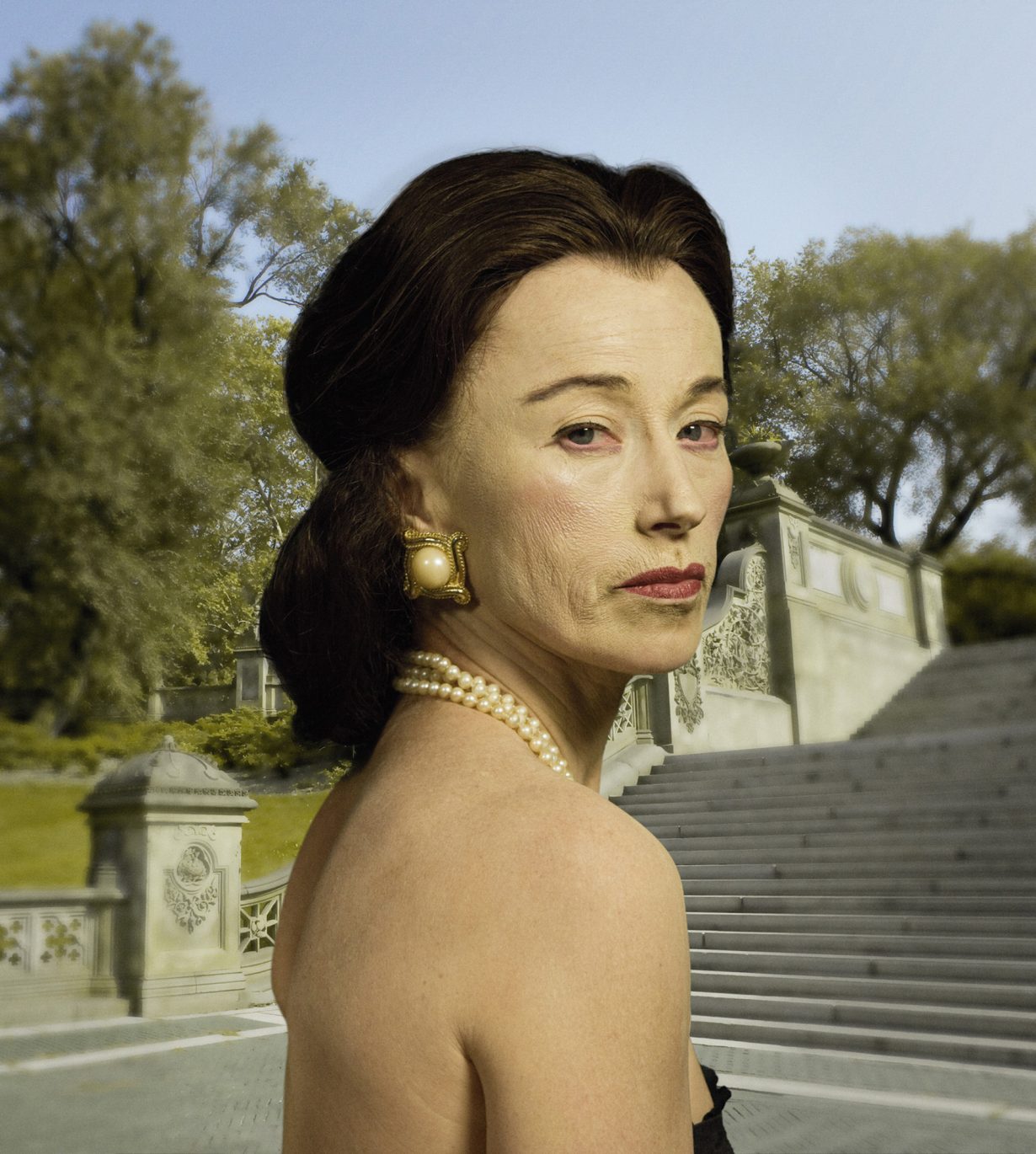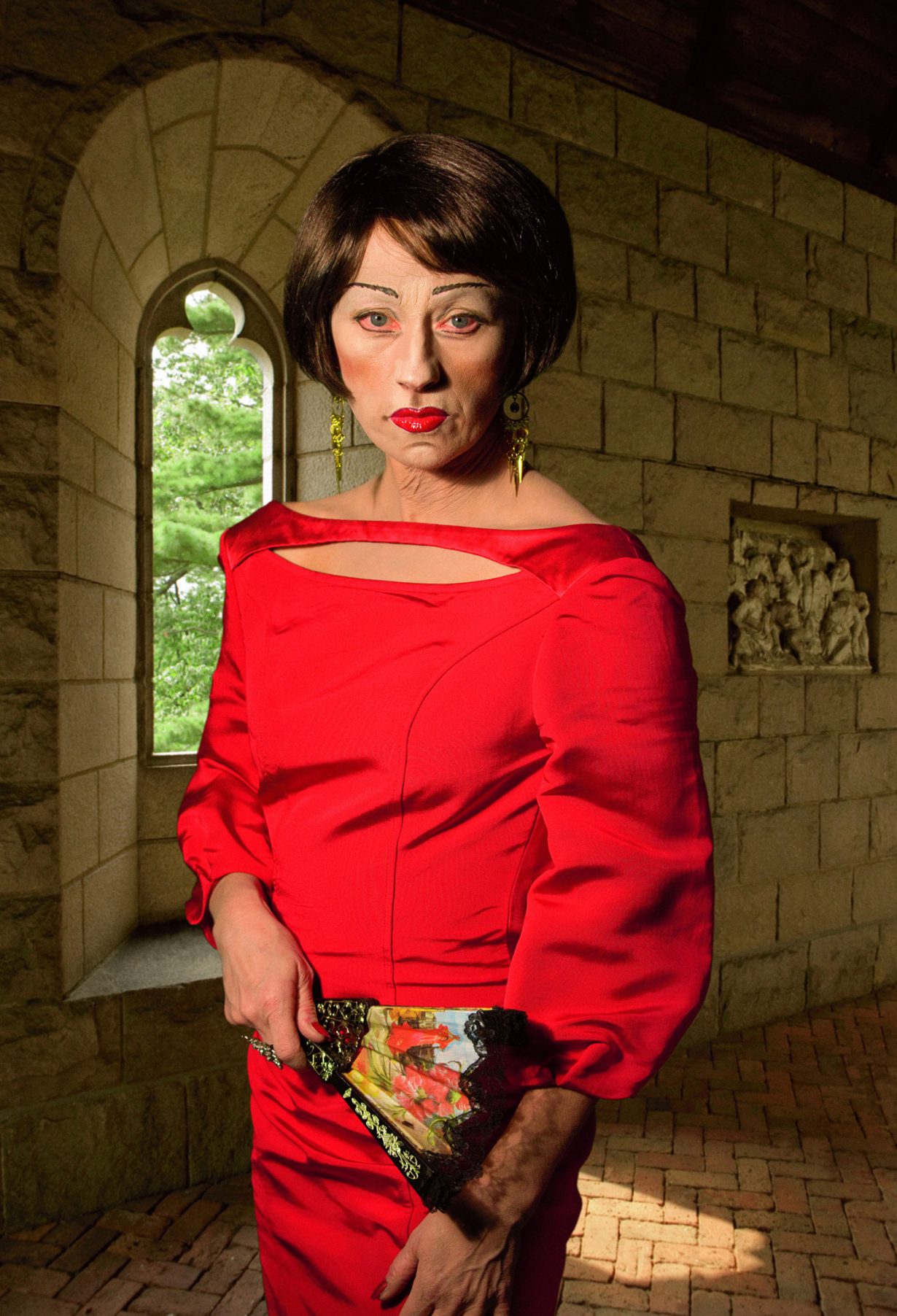“I want to be in control, I guess, of what looks fake and what doesn’t.” On the eve of her retrospective at Fondation Louis Vuitton, Paris, on view from 23 September to 3 January, we revisit our 2009 interview with the artist, discussing her carefully orchestrated world-building, in which fiction and an elusive but ultimately invented reality momentarily cross paths.

Cindy Sherman’s latest cast of characters stake their place on the gallery walls imperiously. At around two by two metres each, they are some of the biggest works she has made, in a career that spans an incredible 30 years.
“One of the reasons I made them so big”, she explains as we talk in one of the rooms of Sprüth Magers’s enormous Berlin gallery, where the work is being shown until mid-April (and after which a selection will move on to London), “is I was noticing how it seemed like women artists hardly ever made really huge things. And I guess I was just noticing, a year or so ago, a lot of really gigantic painting, installations and wall-works by male artists, some of whom weren’t even that well known. Who are they thinking they can sell this to?… It’s this big ego kind of thing men have, rather male artists have. So I decided to see how these would look really big, and I blew them up with the projector and… the sadness of it kind of took my breath away. So they really needed to be that big.’”
Indeed the new series, portraits of Botoxed, ageing female socialites (all played by Sherman herself) posing in front of lavish backgrounds, exudes sadness. Though a number of these characters stare haughtily at the camera, their attempts to cling to youth expose their hauteur as brittle facade. I wonder, as some other critics have noted since this body of work was first shown late last year, at Metro Pictures, in New York, whether these women are based on the first wives of wealthy collectors one might see walking around art fairs, chequebook in hand; the works seem strongly to suggest the centuries-old system of patronage in art. But as it turns out, I’m mistaken.

“I never thought of them as collectors. They’ve got a lot of money, but they don’t know about contemporary art”, Sherman says. She’s being diplomatic, finding a nice way of saying they’ve got dough but no sophistication. Sherman has clearly laboured to make every detail of these women’s appearance accentuate their bad taste, from fake talons to painted-on eyebrows, and finally to the very fact that they have (in the fiction of the work) commissioned someone to create a ‘flattering’ portrait they will likely hang in their own homes.
“Somebody showed me a website of a woman who was a famous soap star in the 1980s. Around that time she made a videotape of herself talking about how [she adopts a snooty voice, enjoying the roleplay] ‘you too could look as fabulous as I do; all you need to do is watch my video and I’ll tell you my makeup tips’. I was watching it, and she was in her living room, and I saw this huge photo of her, of her face, just over the couch. And it made me think how some people, traditionally, have paid artists to paint a portrait of them to put in their homes, usually wealthy people who want to show off their wealth. Somewhere, somehow, this is coded into the image”, she explains.

What is also encoded in the portraits, we suspect to the chagrin of the characters, is the wretchedness of their situation. The contortions wrought from too much plastic surgery, the inescapable wrinkles, indeed the whole range of injustices that age has imprinted on their faces and bodies suggest an underlying melancholy that keeps the work from being mere critique of the rich and tasteless.
Ever since her Untitled Film Stills from the late 1970s, in which she photographed herself in numerous guises for images recalling the promotion shots from noir and new wave films, Sherman has underscored her portraits with pathos, always hinting at the sadness and fear that lie behind the social face. With her new work, Sherman not only highlights but also actively confronts the spectacle of the ageing woman and her inevitable obscuration in daily life. With the exception of one work featuring two women, all portraits show the characters alone in their huge mansions, and the digitally manipulated backgrounds further stress their separation from the real world. In her 1991 essay ‘Suitable for Framing: The Critical Recasting of Cindy Sherman’, Abigail Solomon-Godeau highlighted the way critics often overlooked Sherman’s images of older women, pointing out that ‘Sherman does not just “do” the girl. Also populating the stills are middle age matrons, squalid hausfrauen – and patriarchal euphemism par excellence – women of a certain age. That such types become critically invisible grimly parallels their invisibility in real life.’
Looming at the viewer in sharp focus and in high-contrast colour, the women in Sherman’s latest series this time make their presence painfully known. On the process of coming into character, Sherman says that even she could not foresee just how unsettling the portraits would turn out. She describes the moment as a sort of magical, unexpected event: “In some cases I didn’t even quite understand myself what was happening until I projected [the images] – I used a projector to see how big I wanted them, before I printed them. And when I blew them up, a number of them struck me as so much sadder than I ever anticipated. I realised they were characters who had built a facade of what they were projecting to the world of how happy and successful and useful they were trying to be and yet… In the portrait, you see behind all that need to show off, and you see something more poignant, all the stuff that they’ve had to sacrifice.”

Two works in particular resonate with the sadness Sherman describes. Untitled (#465) shows a woman in a strapless dress, wearing pearls and looking mournfully over her shoulder in front of the imposing steps of her neoclassical home, her expression and small frame against the grandeur of her house telling of a lonely, neglected existence. Another, Untitled (#471), presents a woman incongruously got up in classic prom-queen attire: a lavender satin gown, sporting an up-do and candy-coloured painted nails. Yet her stiff pose and red-rimmed eyes belie the youthful image she is trying to project.
It is always tempting to locate the artist in her work. I ask her why she thinks throughout her career people have been so interested in finding the ‘real’ Cindy Sherman, and the response is characteristically modest: “I really don’t know. Maybe they want to find some kind of connecting point between all these different characters – what the real eyes or nose of that person looks like. Maybe they think that it will inform the image when they look at it again. I don’t think about my work being about identity when I’m doing it. It’s not about me, so I don’t know how to answer that question.”

There is no question the ‘real’ Cindy – who is petite and understated – has been excised from the resulting images. Wigs, costumes, lashings of makeup and numerous prostheses were used to transform her into the grotesque yet curiously affecting figures we see on the gallery walls. ‘Vulnerable’ and ‘exposed’ are words frequently used to describe the women in Sherman’s work, especially in reference to her early images of forlorn girls at train stations, or alone in the big city. I wonder if she views all the trappings and paraphernalia in the latest series as armour for her characters, a means of somehow protecting them from inevitable ridicule.
“No”, she says, laughing. “I probably see all that as armour for myself! Because I don’t want people to think that what I do is some kind of narcissistic thing, because I use myself as the model. It’s a way to take it one step further outside of myself. Early on when I was working on the series, I was questioning whether I really liked the characters. I felt like they were a little close to home, because I wasn’t really depending on fake tits and fake this and shit like that. But I feel that the results seem actually more real; what you see isn’t just someone who has a big fake nose.”
I ask how she feels about shooting digitally, whether she is excited by the possibilities for manipulation it gives. “Working alone in my studio, it’s just so much more helpful”, she says. “Being able to check out what I’m doing as I’m doing it, it’s really changed my whole style of working. But I don’t want things to look digital. I don’t mind people knowing that it’s fake, but I don’t want it looking fake. I want to be in control, I guess, of what looks fake and what doesn’t.’’ This would seem to define her world in a nutshell: a carefully orchestrated one in which fiction and an elusive but ultimately invented reality momentarily cross paths.
From the April 2009 issue of ArtReview. Cindy Sherman at Fondation Louis Vuitton is on view, 23 September 2020 to 3 January 2021.